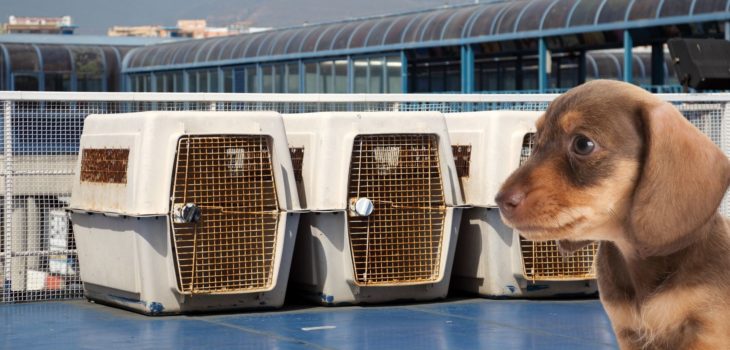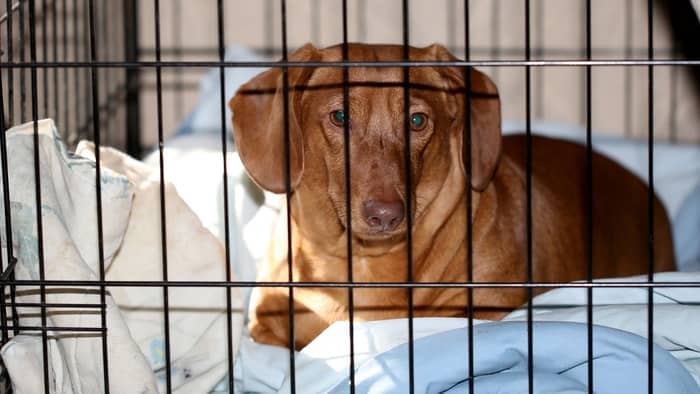Last Updated on May 16, 2022 by Marco
Crate training can be a bit controversial but it’s a perfectly fine thing to do if you do it right. So, how to crate train a dachshund puppy, and why that’s important? How soon should you start, how much time is it going to take, and what’s the best approach? Let’s go over each point below.
How To Crate Train A Dachshund Puppy?
The crate training process is much simpler than many people realize. While dogs aren’t as much of a den animal as some wild canines, they do use dens, particularly when giving birth, caring for their puppies, or when looking for some extra comfort.
So, the idea here isn’t to force your dog into a place it hates and to make it tolerate it. Instead, all you really need to do is make the crate enjoyable and get your dog to the idea that the door will sometimes will be closed.
So, here’s the step-by-step process for how to crate train a dachshund puppy:
- Pick the right crate size. It should be as long as the dog’s nose-to-tail length plus a couple of extra inches. It should be as tall as the dog in a sitting position (not standing) plus a couple of extra inches. And, the width should be 70% of the length. That’s for an adult dog, of course – if your dachshund is still a puppy, get the appropriate size for when it’s an adult.
Learn more about: My Dog Poops In Its Crate When Left Alone – What To Do?
- Put the crate in the right place. It shouldn’t be an overly lively area but it should still be in or near the living room or your home office area. If you plan on training your dog to sleep in the crate at night, it’s smart to put it close to your bed. If need be, you can move the crate between two locations but that should be done consistently so the move can become a part of the habit.
- At first, let your puppy explore the crate freely. Your dog shouldn’t feel forced. On the contrary – the crate should be comfy and interesting enough – it should have your dog’s favorite blanket, some toys, and so on. Add extra rewards by petting and praising your dog every time it enters the crate.
- Start exercising your dog before going to the crate. This will tire your pup out and make it sleepy, leading to a nap time in the crate. This nap time should be done with the crate door still open at first.
- Start closing the door during nap time once the pup has started to feel really comfortable inside. At this point, the dog should be going there on its own anyway. If your dog starts whining and crying at first, don’t be distraught – a few minutes of whining are ok and you can comfort your pup through the crate. This is even easier to do with an open-roof kennel. If the crying persists, take the pup out and play with it some more to get it tired. Then, try again. Also, don’t keep your pup locked in the crate for longer than an hour or two at first – you are still just establishing the habit.
- And that’s about it. After a while, your pup will be comfortable enough inside to stay there all throughout the night – for up to 8 hours! The whole crate training process can be started as early as the pup’s 8th week and can take anywhere between a couple of weeks to a couple of months. If it takes longer than that, you’re either not doing something right or you’re not persistent enough.
As for whether you even need to crate train a dachshund – not really. However, it is a useful tool to have and it’s enjoyable for the dachshund itself when done right. The only time you’ll absolutely need a crate for a dachshund is in case of a physical problem such as IVDD or another issue. For those alone, it’s worth it to have established the habit ahead of time.
FAQs
Are dachshunds hard to crate train?
Not necessarily, at least not more than you’d expect from any other breed. Dachshunds have a reputation for being difficult to train and that’s somewhat true when it comes to stuff such as potty training or complex command training. That’s normal for a scent hound breed as these dogs have been specifically bred to be single-minded, willful, and stubborn in order to be better hounds.
Crate training doesn’t present such an issue, however, as it’s not really “training” per se. Crate training is mostly a matter of creating a cool and comfortable special place for your dachshund and then presenting it to your dog. If the crate is of the appropriate size, has a comfortable interior, and is put in the right place in your home, your dachshund will love using it almost immediately. From there, it’s a matter of getting your dog used to staying enclosed in the crate for a limited amount of time when need be – something easy to do with a few treats and a positive attitude.
How long can a Dachshund stay in a crate?
In extreme situations such as moving or physical rehabilitation after IVDD, a dachshund can stay in a crate for as long as is necessary. However, ideally, an adult dachshund shouldn’t be forced to stay in its crate for more than 8 hours at a time. This is long enough for a good night's sleep and it can sometimes be ok for while you’re at work. If you need to keep your dog in a crate for longer than 8 hours at a time, however, you risk getting an unhappy, depressed, and disobedient dog. Not to mention the risk of toilet or health problems.
Should I put my 8 week old puppy in a crate at night?
Not only should you do that but the 8 week period is the ideal time to start crate training your dachshund puppy. The sooner you start the training, the easier your dog will pick it up. Just make sure not to keep the dog in the crate longer than is necessary. Once you’re up, let the dog out as it will start feeling ignored and punished if you go about your day and you’ve just left it in the crate. Mealtime and playtime should always happen outside the crate.
How long should you let a puppy cry in a crate at night?
Some experts say no longer than 5 minutes, others – up to but no more than 30 minutes. For the earlier days of the training, the latter estimate is probably more accurate as your dog needs to learn that crying won’t get it what it wants. If the crying continues for longer than 30 minutes, however, let your puppy out for a bit and give it some love and attention to prevent anxiety, distrust, and fearfulness. With good crate training, however, that 30-minute period should quickly start dropping down to 4-5 minutes. If it doesn’t you’re doing something wrong.
Jordan is an animal–lover who specializes in dachshunds. He has owned and cared for dachshunds since he was a child, and his passion for these unique dogs has only grown with time. Jordan is an avid researcher and learner, and spends a large portion of his free time studying the history, behaviour, and health of dachshunds. He has a knack for training and socializing his own dogs, and loves introducing them to new experiences. When not caring for his own pets, Jordan likes to volunteer at local animal rescue shelters, helping to find homes for abandoned dachshunds. He is a true animal advocate, and dedicates his time to ensure that all animals receive the love, respect, and care they deserve.





